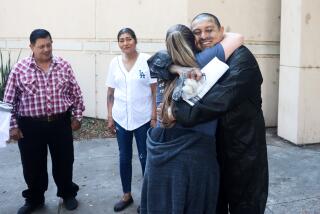Fear and Ignorance Seed a Bitter Harvest
Itâs the perfect crime, the toughest murder to crack. And recently it happened again. A transient rummaging for food in a trash can along Pacific Coast Highway in Malibu found yet another Baby Doe.
Last year, L.A. County sheriffâs deputies investigated the deaths of three infants found in dumpsters or trash cans or at the sides of roads. There were two such cases in the city of Los Angeles. Adding other cities to the total, there were 10 cases of dead, abandoned babies in L.A. County in 1996.
All are unsolved.
Orange County sheriffâs officials said there were perhaps a couple such unsolved cases last year--they donât specifically track infant deaths--and none so far this year.
The numbers of these infant deaths seem to be leveling off, but childrenâs advocate Deanne Tilton Durfee warns that statistics do not tell the entire story of this infanticide. âFor every child we find,â says Durfee, director of the L.A. County Inter-Agency Council on Child Abuse and Neglect, âthere are possibly 10 more.â
âIf I were to put a baby in the trash in my neighborhood,â she says, âit would probably never be found.â
They become the most difficult cases because many of the bodies that are found are newborns who have no earthly records, not even names. Some are so young that their ethnic heritage doesnât yet show. The first step in any murder investigation is establishing the identity of the victim. This would bring police back to the victimâs home, friends, family and circumstances in life.
âWithout a name, law enforcement doesnât have a beginning,â says L.A. County coronerâs official Doyle Tolbert. âItâs square one.â
âWe have no way of tracking the child,â says Lt. Verne King, head of the Los Angeles Police Departmentâs Abused Child Unit. âThatâs when you see us on the news asking for help from the public.â
And sometimes itâs not even clear whether these babies were stillborn, choked to death, abused or simply that they died after being abandoned. Decomposition can add to the quandary. âSometimes the body has been there for more than 24 hours,â King says.
Abandoned infants are but a modern twist on an ages-old phenomenon.
Infanticide was known to the ancient cultures of Egypt, Greece and Rome, and was often considered a religious sacrifice. Until the 1800s in India, it was considered acceptable, even laudable, to give up oneâs firstborn in the name of religion. And in hard and overcrowded times past, Polynesians and Eskimos were known to kill female infants--a practice still seen in modern China.
Police say itâs impossible to say why parents leave their children for dead, or leave dead children in the trash.
âMost are killed before they are abandoned,â Tolbert says. âSome are obvious, with a Venetian blind cord wrapped around its neck or with clear strangulation or suffocation. Some are drug babies. Some are just unwanted. I donât know. I wish I could put a tag on it.â
Childrenâs advocate Durfee thinks the phenomenon owes to poverty, incest, rape and sheer immaturity--as well as the backlash against illegal immigration--and Proposition 209--which would make publicly funded postpartum medical help and counseling off-limits to newcomers.
âWe presume that the number of such infant deaths often reflects young mothers who felt unsafe in telling anyone they were pregnant, didnât know they were pregnant or had no sense of an alternative,â Durfee says. âThis might increase with the diminishing resources for immigrants.â
But evidence suggests that not all parents who leave their babies for dead are young and poor. And in some cases, mothers suffer from postpartum depression and psychosis.
In those few cases where parents of dead infants are identified and charged, full convictions are rare, experts say. Suspectsâ attorneys often relay tales of hardship that bear out Durfeeâs theories, and juries rarely dole out hard time.
âThe parents are young and frustrated and . . . donât view it as homicide,â says Paul Mones, a Santa Monica-based childrenâs rights advocate and attorney who has consulted on more than a dozen such cases. âNeither do the juries.
âThis society still regards the lives of children less than it regards the lives of adults,â Mones says.
What can be done? Education, says Durfee.
âPrevention of the birth is extremely important,â she says. âWe also need to assure that women, particularly young women who find themselves pregnant, they should feel free to be able to discuss this with someone, and every high school should have someone to do this.â
In addition, Durfee wants women to know that putting a child up for adoption is always an option. She encourages parents who are considering giving up their children to call the Baby Anthony Program--an area project sponsored by the St. Francis Medical Center in Lynwood that will have an ambulance dispatched to pick up an unwanted child--at (800) 606-2229.
More to Read
Sign up for Essential California
The most important California stories and recommendations in your inbox every morning.
You may occasionally receive promotional content from the Los Angeles Times.










